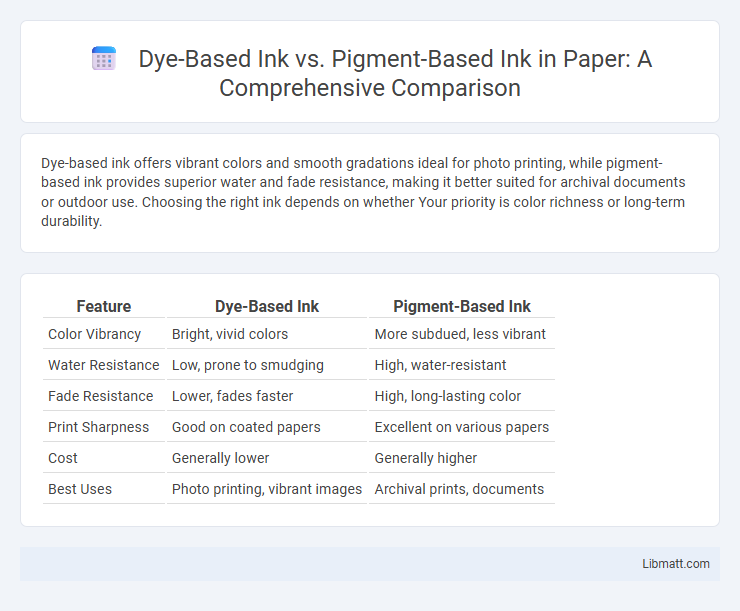Dye-based ink offers vibrant colors and smooth gradations ideal for photo printing, while pigment-based ink provides superior water and fade resistance, making it better suited for archival documents or outdoor use. Choosing the right ink depends on whether Your priority is color richness or long-term durability.
Table of Comparison
| Feature | Dye-Based Ink | Pigment-Based Ink |
|---|---|---|
| Color Vibrancy | Bright, vivid colors | More subdued, less vibrant |
| Water Resistance | Low, prone to smudging | High, water-resistant |
| Fade Resistance | Lower, fades faster | High, long-lasting color |
| Print Sharpness | Good on coated papers | Excellent on various papers |
| Cost | Generally lower | Generally higher |
| Best Uses | Photo printing, vibrant images | Archival prints, documents |
Introduction to Dye-Based and Pigment-Based Inks
Dye-based inks consist of colorants dissolved in a liquid, producing vibrant and bright prints with excellent color gamut and smooth gradients, ideal for photo printing and detailed artwork. Pigment-based inks contain fine, solid pigment particles suspended in a liquid, offering superior water and fade resistance, making them suitable for archival documents and outdoor applications. The fundamental difference lies in their chemical composition, which influences print longevity, color intensity, and compatibility with various paper types.
Composition: How Dye and Pigment Inks Differ
Dye-based inks consist of colorants dissolved in a liquid solvent, allowing them to penetrate paper fibers for vibrant and smooth color reproduction. Pigment-based inks contain microscopic solid particles suspended in the liquid, creating a layer on the paper surface that offers superior water and fade resistance. Choosing between these inks affects your print quality and longevity, with dye inks excelling in sharpness and pigment inks providing durability.
Color Vibrancy and Print Quality Comparison
Dye-based ink produces more vibrant and saturated colors, making it ideal for high-quality photo prints and images with rich color depth. Pigment-based ink offers greater color stability and sharpness, resulting in longer-lasting prints with less fading over time, especially on matte or textured papers. Choosing between the two depends on whether immediate color vibrancy or long-term print durability is prioritized.
Water and Fade Resistance: Longevity of Prints
Pigment-based ink offers superior water and fade resistance compared to dye-based ink, making it ideal for prints requiring long-lasting durability. Dye-based ink tends to absorb into paper fibers, resulting in vibrant colors but lower resistance to water and UV exposure. You should choose pigment-based ink for archival-quality prints where longevity and color stability are critical.
Suitability for Different Printing Applications
Dye-based ink is ideal for vibrant photo printing and general paper use due to its excellent color range and smooth finish but tends to fade faster and is less water-resistant. Pigment-based ink offers superior durability, water resistance, and archival quality, making it suitable for professional documents, fine art prints, and outdoor signage. Your choice depends on whether you prioritize color vibrancy or longevity for the specific printing application.
Drying Time and Smudge Resistance
Dye-based ink typically dries faster on plain paper due to its water-soluble nature, allowing quicker absorption into the fibers. Pigment-based ink offers superior smudge resistance because its color particles sit on the paper surface, creating a more durable, water-resistant finish. For projects requiring rapid handling and vivid colors, dye-based ink is preferred, while pigment-based ink suits archival printing demanding longevity and smudge-proof results.
Printer Compatibility and Maintenance Considerations
Dye-based ink is commonly compatible with a wide range of inkjet printers, especially those designed for photo printing, but it tends to require more frequent printhead cleaning due to its liquid composition that can clog nozzles. Pigment-based ink, often used in professional and industrial printers, is more chemically stable and less prone to clogging, resulting in lower maintenance needs and extended printhead longevity. Choosing between the two depends on printer model specifications and maintenance capacity, as pigment inks generally demand less frequent cleaning cycles but may require printers specifically equipped to handle their particulate nature.
Cost Analysis: Dye vs. Pigment Ink
Dye-based ink generally offers a lower initial cost compared to pigment-based ink, making it a budget-friendly option for everyday printing needs. Pigment-based ink tends to be more expensive upfront due to its complex manufacturing process but provides superior longevity and water resistance, potentially reducing long-term replacement costs. Evaluating the total cost of ownership reveals that pigment inks may deliver better value in professional or archival printing where durability is essential.
Environmental Impact and Safety Aspects
Dye-based inks, composed of water-soluble colorants, tend to break down more quickly in the environment but may contain volatile organic compounds (VOCs) that can affect indoor air quality during printing. Pigment-based inks, featuring solid color particles, exhibit greater durability and resistance to fading while generally having lower VOC emissions, making them safer for prolonged exposure and more environmentally stable. Choosing pigment-based inks supports reduced chemical runoff and enhances printing safety by minimizing toxic exposure compared to dye-based alternatives.
Choosing the Right Ink for Your Needs
Dye-based ink offers vibrant colors and smooth gradients, making it ideal for photo printing and projects requiring rich color depth. Pigment-based ink provides superior water and fade resistance, ensuring longevity for documents and archival prints. Understanding your project's requirements helps determine whether your priority is vivid imagery or durability.
dye-based ink vs pigment-based ink Infographic

 libmatt.com
libmatt.com